Rotala Macrandra is an aquarium plant that is very popular in the aquarium trade for its beautiful coloration and it has widely been used in aquarium decoration. He plant is native to India known to thrive in marshy areas. This is one aquarium plant that can be tempting for even the novice aquarist due to its coloration but can be very demanding. The plant is known to require intensive care for it to thrive. It requires soft water, a substrate that is nutrient rich, intense lighting, and CO₂ injection. When placing Rotala Macrandra in the aquarium it is best to have it planted in the middle center of the aquarium.
The Rotala Macrandra is an Asian plant discovered in abundance in India’s marshy regions. Botanists have discovered that the Rotala Macrandra grows best in 4 South Indian states: Tamil Nadu, Maharashtra, Kerala, and Karnataka. High levels of light, scant cover, and cool water with a leisurely flow are all available in these places.
| Information Chart | Rotala Macrandra |
|---|---|
| Scientific Name: | Rotala Macrandra |
| Family: | Lythraceae family |
| Care Level: | Hard |
| Growth Rate: | Moderate to fast |
| Maximum Size: | 8 -12 inches |
| Minimum Tank size: | 40 litres or 10 gallons |
| Water Conditions: | Moderate |
| Lighting: | High |
| Propagation: | Head Cuttings |
| Placement | Mid ground or Background |
Because of its crimson leaves and rapid development rate, the Rotala Macrandra is very popular among fishkeepers of all levels. The Rotala Macrandra comes in several colors, but the red Rotala Macrandra is the most prevalent. It’s known as the Giant Red Rotala since it might grow up to twelve inches tall and has a rich red color to its leaves.
Table of Contents
Appearance of Rotala Macrandra

The plant has got small leaves that may appear green, tan to red, something that usually makes it a favorite plant for aquarium decoration. Indeed it is perfect choice for mid-ground in an aquarium setting to bring about vibrant coloration as well as contrast to the aquarium. Magenta plants absorb green light and reflect red and blue lights; thus, when red and blue lights mix, they appear to us as magenta, while green plants absorb blue and red lights, which when blue and red lights mix, they, in short, absorb magenta and reflect green light.
The plant has a faster growth rate, and with all the necessary micronutrients provided, it is known to grow dense leaves that require regular pruning. When the plant is in top condition, it usually exhibits some of the best colorations you can find in aquarium plants. A mix of Rotala macrandra variants; these aquatic plants are all the same species, Rotala Macrandra, but different breeds or varieties. As you can see, magenta plants give the tank a lot of contrast and color.
Origin
The plant was originally discovered in India where it is native to and is usually found growing in marshy areas. Basically the plant is native to four isolated localities of the four South Indian states of Tamil Nadu, Karnataka, Kerala, and Maharashtra. The plant is considered as a least concern plant species with no threats to continued existence recorded.
The plant is commonly found in lagoons, streams, flooded paddy fields and temporary ponds. It has been found to grow in submerged conditions where it grows thin leaves that are more or less translucent. Sometimes the color in submerged conditions may be pale green, pink or red. The plant is only known to grow in softer freshwater and thus if you are planting it in an aquarium setting ensure the water is fresh and soft.
Varieties Of Rotala Macrandra Plant
There are several varieties of Rotala Macrandra, and each has distinct features. Let’s have a brief look at the varieties.
Rotala Macrandra ‘Variegated’
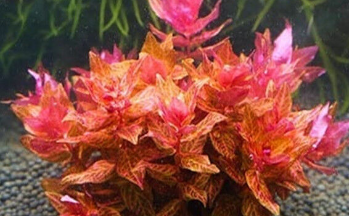
Rotala Macrandra ‘Variegated’ is bigger than the regular Red Rotala Macrandra. It has broad wavy leaves with white venation.
Furthermore, in an aquarium setting, the variegated kind is more difficult to grow and maintain. The Rotala is a rare aquatic plant commonly called Rotala Macrandra. A variegated plant has two or more distinctive colored portions.
The veins of this plant are not red-pigmented as they are in most plants. The venation’s whiteness
Rotala Macrandra is one of the most difficult to keep alive and find in North America. Those searching for one may just have to import from another country or buy it from a private vendor.
Rotala Macrandra Green Types
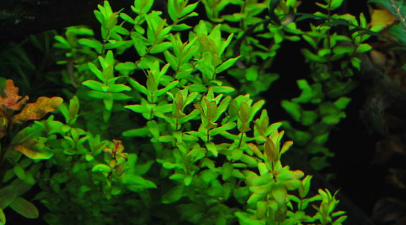
These varieties are famous for possessing tall stems and much more green leaves, with little pink or scarlet hues primarily toward the top. They’re also the easiest of the Rotala Macrandra kinds to grow.
This plant, like Rotala Macrandra red, is difficult to maintain. Fortunately, the standards for this new variant are less stringent than for the regular variety. The green variety thrives in medium-light aquariums and is slightly more tolerant of low pH balances of 4.5 to 7. The green variety, as opposed to the original red, can grow much higher; hence it is best employed in a bigger tank. In terms of positioning, this variation works best as a background plant.
Rotala Macrandra Red Variations
These varieties have a lot of red leaves down, and they’re a little more difficult to cultivate in a freshwater aquarium.
Rotala Macrandra ‘Narrow Leaf’
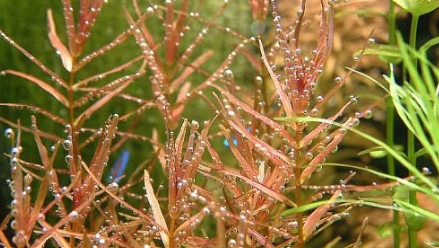
It is one of the varieties in Rotala Macrandra that has a lot of branches. This type has a lot of narrow or almost lanceolate leaves that are brilliant red-colored. This plant, also known as Rotala Macrandra “magenta” and Rotala Macrandra “Florida,” is a mutation of Rotala Macrandra, one of the most popular commercially available variations in the United States.
As the name suggests, it has smaller leaves and a more upright growth habit than other plants of its kind. The narrow leaf is comparable to the green form in terms of what it requires to survive. If you want to get the greatest colors out of your plant, you’ll need to have more nutrients in iron, carbon dioxide, and brighter lights.
Rotala Macrandra ‘Mini Butterfly’
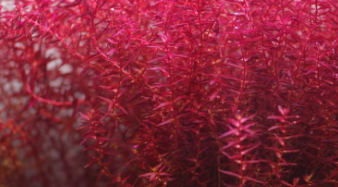
This type looks like Rotala Rotundifolia, but it has a darker red tone with leaf margins rolled outwards. It’s difficult to cultivate, particularly in low-tech tanks.
Rotala Macrandra ‘Mini Type 4 Green
Rotala Macrandra ‘Small type 4 green has soft green leaves with serrated leaf margins that are somewhat big. Under high-intensity lighting, this type generates orange colors that match the aquascape’s reds and greens.
Rotala Macrandra ‘Tiny Type 4 Red
This variety has the same characteristics as the mini type 4 green. Still, it has a deep red hue and demands high illumination, nutrient-rich substrate, and enough water column fertilization.
Rotala Macrandra ‘Mini Type 2’
Its unusual, curled leaf edges are primarily green with pink and orange highlights. This kind, like other minis, is difficult to cultivate and sustain in the long run.
Rotala Macrandra Size
The typical Rotala Macrandra grows up to 8 inches on the lower end and 12 inches for larger specimens
Rotala Macrandra Care and Tank Set-Up
Rotala Macrandra Tank Size and Specifications
The optimal specifications to establish the required tank size are mentioned below.
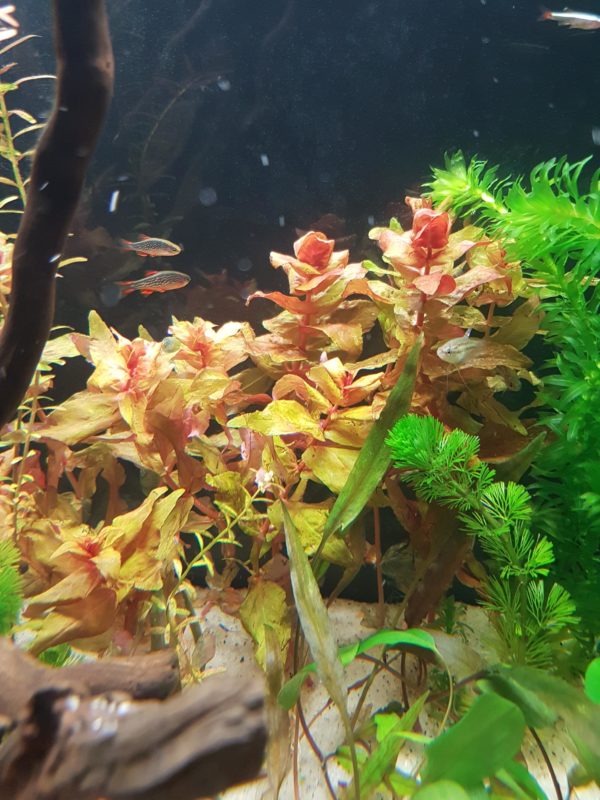
Optimum Tank Size for Rotala Macrandra Plant
The recommended tank size for Rotala Macrandra Plant is 10 gallons or approximately 40 Litres.
Tank Shape for Rotala Macrandra Plant
The preferred tank shape for the rotala macrandra plant is rectangular.
Substrate
Nutrient-rich substrates are required for the growth of this plant. Iron-rich, somewhat acidic substrates and high phosphate content in the water are desirable (1.5 to 2.0 ppm). Maintain a low number of nitrates (10 ppm or less). Too much nitrate in the soil causes leaf tips to turn orange, yet insufficient nitrate levels might imitate the signs of low light.
Experienced users suggest a few substrates for the sustainable development of the plant.
- ADA Amazonia aqua soil
- CaribSea Eco-Complete
- Seachem Flourite
In the absence of nutrient-rich substrates such as Amazonia soil, root tab or fertilizer can prove a great addition. Aquarium light and the intensity depend on the type of plants selected for the new aquascape. Usually, 6–8 hours of aquarium light are enough for a planted tank. You can add a CO2 system to boost the growth of the plants, but it is not a mandatory requirement.
How Many Rotala Macrandra Plant Can Grow In 10 Gallon Tank
Minimum of 3 to 4 plants can grow in a 10-gallon tank.
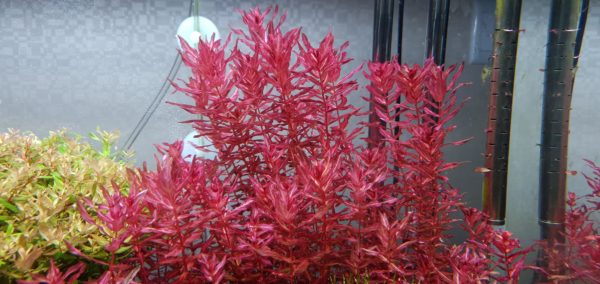
Water Parameters for Rotala Macrandra Plant
Water Temperature
The ideal water temperature for Rotala Macrandra Plant is 22-26oC
Ph Level
The perfect water pH level for the Rotala Macrandra plant is 6.0-7.5 [pH]
Water Hardness
The hardness of the water should be maintained around 3 to 8 dKH.
Rotala Macrandra Plant Tank Landscape
This red plant will be compatible with various aquarium plants by sharing similar tank parameters.
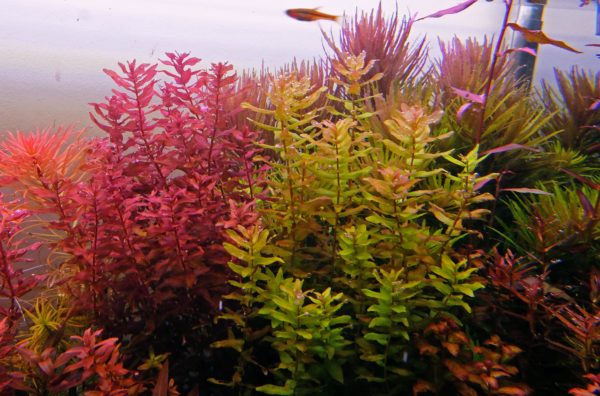
Decorations For Rotala Macrandra Tanks
Rotala Macrandra’s shape and appearance will complement your aquascape well.
Lighting For Rotala Macrandra Plants
When it comes to light requirements, Rotala Macrandra is fairly demanding.
To thrive and retain strong colors in a planted tank, most species of this species require high-intensity illumination.
As a result, make sure you use high-quality LED aquarium lights or other appropriate aquarium light sources to give ample illumination.
Maintaining optimal PAR values and a standard photoperiod is also important for the health and vigor of the plant’s shoots. Also, the lowest portions of Rotala Macrandra may melt in the tank due to taller plants’ insufficient light or shadow; therefore, try to avoid such scenarios.
Rotala Macrandra Compatibility and Tank Mates
Ideal Tank Mates for Rotala Macrandra
The species that can sustain better with the Rotala Macrandra plants are ideal tank mates.
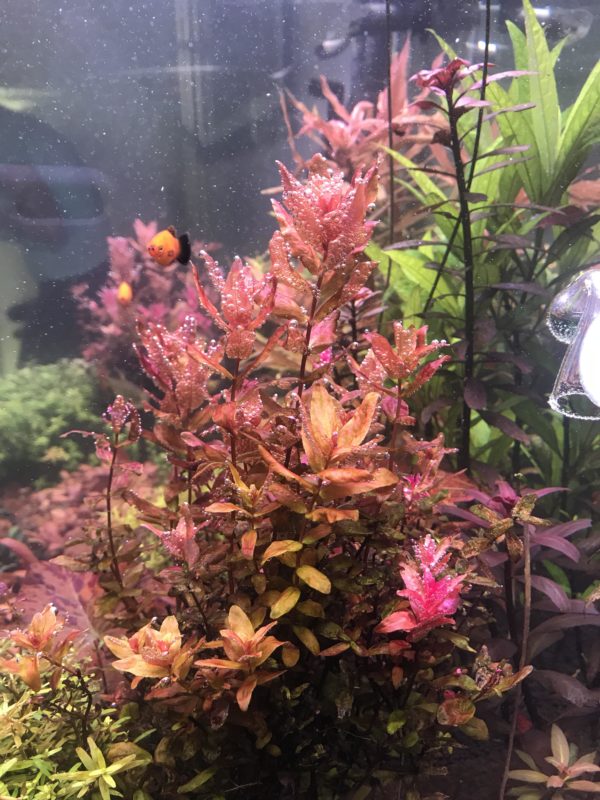
- Bettas
- Tetras
- Pearl Gourami
- Honey Gourami
- Danios
- Cherry Barbs
- Platies
- Guppies
- Endlers
- Mollies
- Otocinclus Catfish
- Pygmy Cory Catfish
Bad Tank Mates for Rotala Macrandra
Species which you should avoid with the Rotala Macrandra plant are known as Bad tank mates.
Avoid the below-mentioned fishes in your tank.
Facts About Rotala Macrandra Plant
- Rotala Macrandra plant belongs to the Lythraceae family
- Rotala Macrandra is a common red plant in freshwater aquariums. Its leaves stand out against the regular greens and browns in many fish tank layouts.
- This plant grows up to 4 to 12 inches in height
- Due to its bright color; it adds beauty to the aquarium
- It provides a hiding place for the shrimp and fishes in the aquarium
- It oxygenates and helps in aerating the water
- This plant can be placed either in the midground or background in the aquarium
- Moderate or intensive care is required for the growth of the Rotala Macrandra Plant
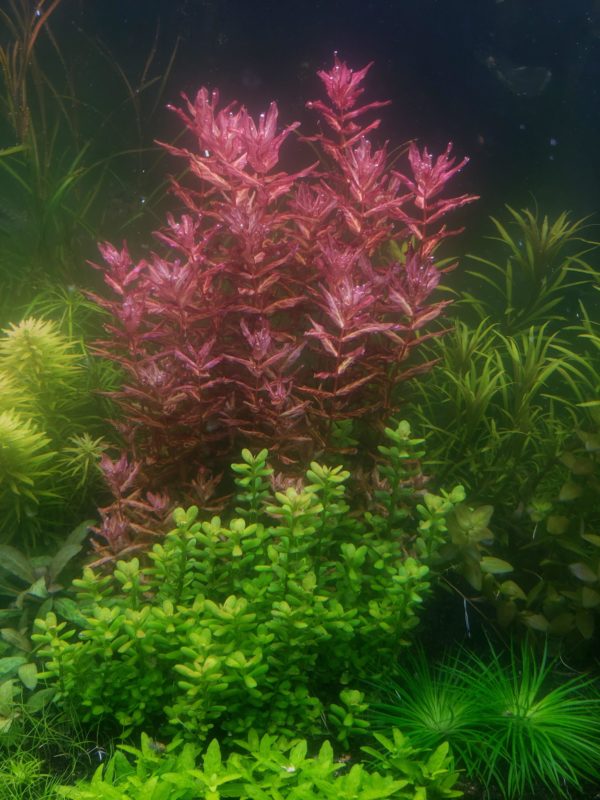
Are Rotala Macrandra Plants Right for You?
Rotala Rotundifolia is an excellent plant for both novice and advanced aquarists. The plant is a terrific addition to aquariums, and its vivid green and red hues offer an aesthetically pleasing contrast to any tank. It is appropriate for mid-ground and background placement.
This plant’s dense, vivid foliage makes an attractive focal point, and you can combine it with other plants of varied hues for a more artistic and energetic impact in the tank.
Invertebrates will employ Rotala Rotundifolia for feeding, breeding, and molting purposes in shrimp aquariums.
This Rotala Macrandra plant is recommended for expert aquarists. Beginners may try to cultivate this plant in the aquarium, but it is recommended to do it with a more experienced aquascape.
FAQs
In What Quantities Should the Nutrient Levels Be Maintained?
Appropriate nutrient levels are needed to help keep the plant in great form. If you wish to achieve an intense deep-red coloration from the plant, you may need to keep the phosphate levels in the aquarium relatively high.
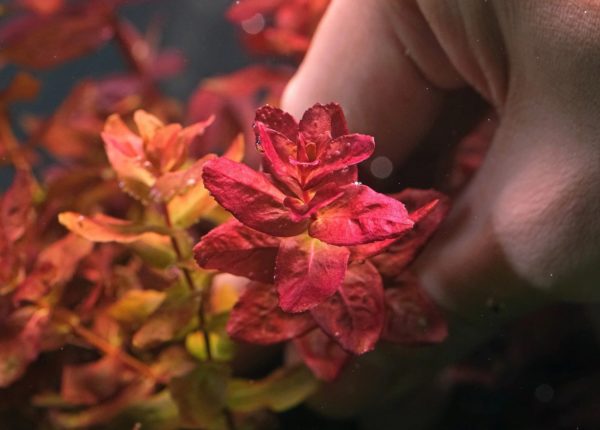
While keeping the levels of phosphate high, ensure that you keep nitrates to low levels as much as possible. With high nitrate levels, the plant is known to experience stunted growth with a kind of orange-like coloration. Just be sure not to deny the plant a good share of nitrate, as nitrates deficiency may also cause similar symptoms to when there is insufficient light for the plant.
Is Carbon Dioxide Required for The Growth of The Rotala Macrandra?
Performing carbon dioxide supplementation is not a must but will greatly help improve the plant’s condition. Even though the plant is highly demanding when it is still being established in the aquarium, once it gets started and perfect conditions are offered, it is a very rewarding plant. Under great optimum conditions, it is known to grow even up to 3 or 4 inches every week.
What Is the Use of Rotala Macrandra in The Aquarium?
Due to the plant’s interesting coloration, it is most commonly used in aquarium beautification. It is best used in the mid areas of the aquarium for it to bring out color dominance at the center. It is best to plant it sparingly because its strong coloration may overshadow an otherwise well-balanced aquarium. You can plant a few stems in between other light-green plants in color. This may help bring about a strong point of visual interest that can be captivating. It is also one of the main features of a Dutch aquascaping style.
How Does Cultivation/Propagation of The Rotala Macrandra Take Place?
Rotala Macrandra is usually propagated by way of the stem; you can insert stem cuttings in a nutrient-rich substrate, and new plants will grow. The ‘parent stem’ will grow very fast with a nutrient-rich substrate. Just ensure that the water is well checked and is not clogged with lots of nitrates as this will gravely affect the growth of the new plant.
The roots of the cutting will grow quickly, and the shoot will also grow up fast. If the tank conditions are optimum, the new plant will grow into a lush, bushy plant!
How To Trim the Rotala Macrandra Plant?
Rotala Rotundifolia requires regular trimming (dense form bushes) to gain density. Trim the plant’s tops to around 10 cm below the desired height.
Cut the tops that grow quicker than the others as they grow out. It allows the branches to split and the crown to grow denser as it rises upwards. After that, you can either throw away the trimmed bits or replant them.
Conclusion
Rotala Macrandra is a popular aquarium plant most commonly used in aquarium scaping. It is known to grow relatively fast when the conditions in the tank are favorable with sufficient nutrients. It is a freshwater plant that is native to the Asian Nation of India, particularly to Southern states. The plant is known to grow in streams, ponds, small rivers, and flooded paddy fields. It is a demanding aquarium plant that is not ideal for beginners and is best left for experienced aquarists. Just ensure that you provide it with sufficient nutrients, and it will reward you handsomely!
You can also share your experiences in the comment section below!
